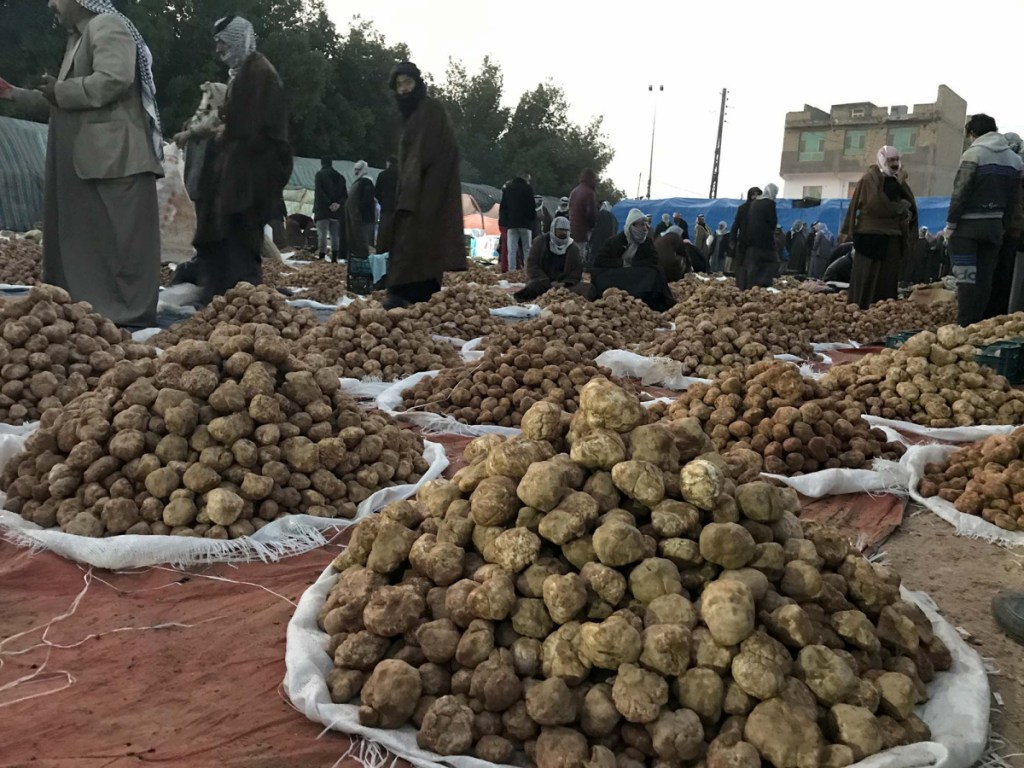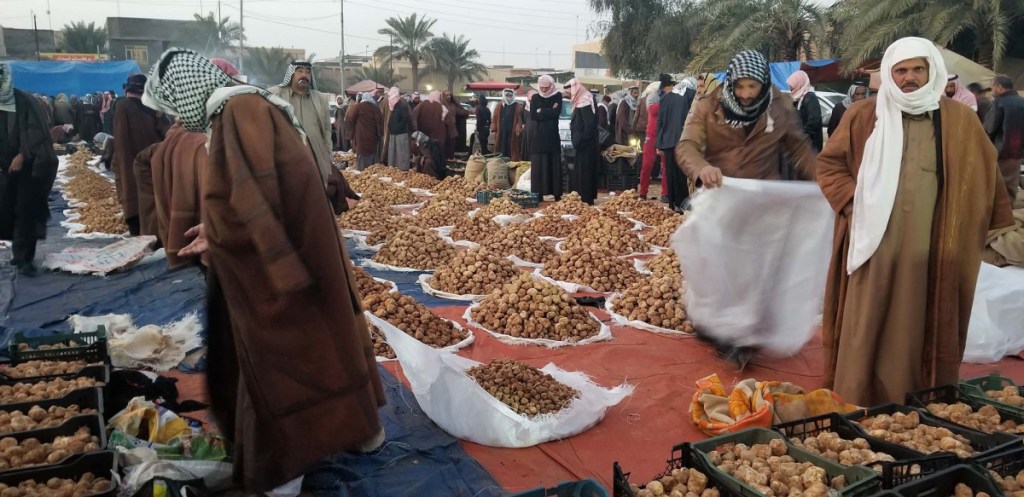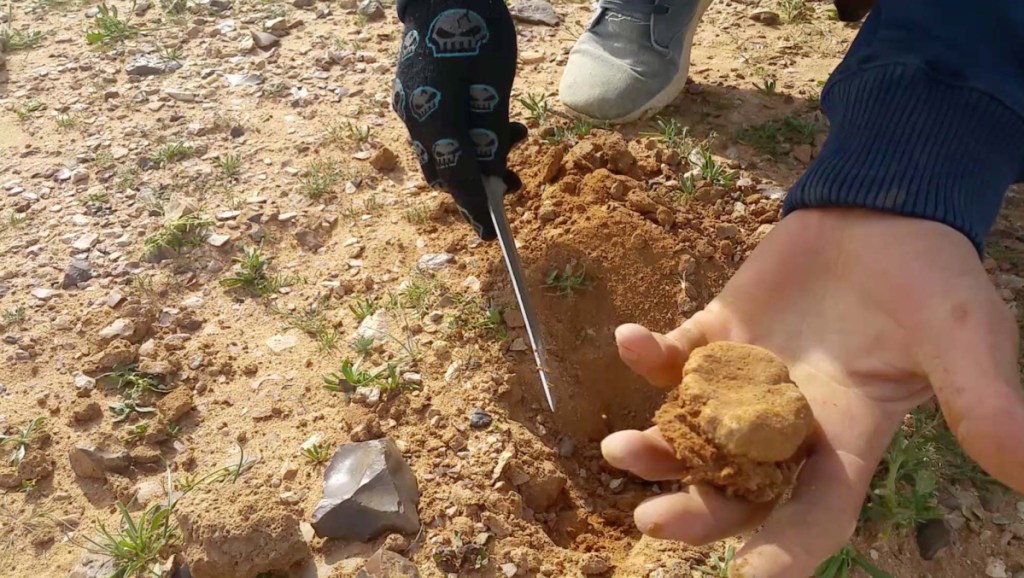EKEYRAN, Iraq — To reach Ekeyran, a place so desolate no one has bothered to put it on a map, you must abandon the bustle of Baghdad for a 173-mile jaunt to the city of Samawah, dodge camel caravans while driving over to Al Salman district – onetime home to Saddam Hussein’s harshest prison – then find a Bedouin guide to drive you two more hours deep into the uncharted desert plains near the Iraqi-Saudi border.
There, buffeted by roaring winds amid near-freezing temperatures, you too can slowly wander the barren landscape, knife in hand as you scour the ground for hours in search of the almost cruelly obscure signs hinting at your quarry.
What is it you seek? The inauspicious-looking bonne bouche known as the desert truffle.
Delicate, subtle, light yet satisfying, the desert truffle has much of the magic of its more prestigious (and rarer) European counterpart.
Because Iraqi food has all the subtlety of a stampede – consider kahi, a flaked pastry soaked in cardamom-infused syrup and clotted cream – you might think truffles would be ill-suited for such a cuisine.
You’d be wrong.
Everything about the truffle exemplifies the food-as-challenge aspect of so many ingredients in the Iraqi cookbook.
And for those who prize the desert truffle – and many do, sometimes at the risk of their lives – finding it means nothing less than a quest for treasure, one that mixes equal parts timing, superstition and danger.
TIMING IS KEY
First the timing. To get truffles, you need water, a fair amount of it too. But it all depends on when the first rain begins to fall.
Storms in October, November, even as late as December can herald a good harvest. Anything after, says Nofal Saleh, a mustachioed 35-year-old Bedouin, is just too late.
Saleh, who has long roamed Iraq’s south for kama, as truffle is known in Syria and Iraq, is perched one winter day in the passenger seat of a van, scanning the horizon.
He’s swathed in a fur-lined abaya, a long cloak, and black-and-white kaffiyeh headdress to protect him from the elements. He points to what appears to be a random spot on the road, a signal to veer off into the desert.
As the van bumps over the harsh terrain, Saleh points to what looks like one indistinguishable area after another, yet he produces a Bedouin name for each as he marks a path heading ever closer to the Saudi border.
He counts off fingers as he begins a detailed litany of good and bad truffle seasons stretching back to 2004.
“This year the first rains fell on the 20th of October,” he says. “Pretty good.”
SUPERSTITION PLAYS A ROLE
The storms are also where superstition comes in. Thunder and lightning are said to boost the alchemy of the truffle, a species of mushroom that grows in different types all across the arid and semiarid areas around the Middle East and zones around the Mediterranean.
The most common truffle type here is terfezia, an off-white, sponge-surfaced variety that looks rather like the rocks dotting much of the flat sand and gravel plains of Iraq’s south. That hard terrain perhaps explains the need for meteorological fireworks.
Thunderclaps crack the surface of the ground like an eggshell, some say, allowing the microscopic spores to spread below the sand to flourish.
Science, however, gives a less fanciful explanation, asserting that thunderstorms generate water-soluble nitrogenous compounds. They fall with the rain and encourage growth.
Timing is also essential for the harvest. The season is fleeting, lasting a mere three months in the arid lands of Iraq and Syria. But woe be to those who dally, Saleh warns.
“By late March it becomes disgusting,” he says, wrinkling his nose at the remembrance of past truffle hunts gone bad. “It has worms in it and smells like a rotting corpse.”
Saleh continues scanning the seemingly unchanging landscape, then suddenly announces it is time to stop. He takes a moment to adjust his robes, wrapping them around himself in preparation for the elements. He opens the door, and the pressurized quiet of the cabin gives way to a growling wind.
How do you know your quarry lurks under the surface, without the benefit of truffle-sniffing dogs or pigs, which are considered unclean by Islam? With great difficulty, at least for the untrained eye.
One clue is the appearance of cracks in the soil, indicating the truffle is bulging its way toward the surface. Another is the appearance of a certain grass, called aneyd by the Bedouins here. If you see it, they say, truffles are nearby.
This observation is also borne out by research, with studies finding that desert truffles, like most of their ilk, form symbiotic relationships with certain plants and can be found close to their roots.
Unfortunately, aneyd looks almost identical to another weed.
That is one explanation as to why, after walking the uninterrupted plains, squinting at the ground, you may find yourself sans truffle.
None of this slows Asaad Jabaali, who is leaning against the wind, his robes flapping. The 23-year-old pounces on one promising spot, then another.
Once all the clues converge, he squats over the prospective site, brandishing a long kitchen knife to cut a quick circle around the spot. He works the surface with both hands to reveal the rotund outlines of the truffle. He gently works the knife at an angle underneath the truffle, and pops it out.
It gets a quick examination, with Jabaali dusting the truffle off before plopping it in a ragged-looking cloth pouch and continuing his search.
DANGEROUS HARVEST
But harvesting can also be where the danger comes in, for the finest truffles are found where foragers face extreme threats.
One such danger zone is the Iraqi-Saudi border, where in December, Saleh says, overzealous Iraqi guards shot what they thought was a smuggler but was actually a truffle forager.
“The truffles there are huge, the size of a pomegranate,” says Saleh, a hint of awe in his voice. “But only the guards are benefiting from them now.”
To the southeast you might encounter land mines, vestiges from the war with Iran.
In the western Iraqi province of Anbar, home to the reddish, smaller iteration of desert truffle known as hargi, truffle hunters had to contend with the threat from the Islamic State.
But for many, the danger is worth it, especially if market forces are on their side.
In dedicated markets stretching from Al Salman to Baghdad, hunters and merchants arrive before daybreak to peer at squat stacks of truffles piled on blankets and brimming in baskets alongside the street.
They engage in rapid-fire auctions, where quality truffles command prices as low as roughly $3 a pound all the way up to more than $10 a pound in Baghdad and nearly $25 when exported.
Copy the Story LinkSend questions/comments to the editors.





Success. Please wait for the page to reload. If the page does not reload within 5 seconds, please refresh the page.
Enter your email and password to access comments.
Hi, to comment on stories you must . This profile is in addition to your subscription and website login.
Already have a commenting profile? .
Invalid username/password.
Please check your email to confirm and complete your registration.
Only subscribers are eligible to post comments. Please subscribe or login first for digital access. Here’s why.
Use the form below to reset your password. When you've submitted your account email, we will send an email with a reset code.